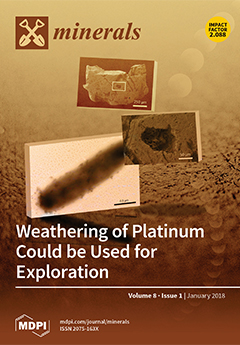In this paper, potassium salt roasting additives were applied to extract vanadium from vanadium–titanium magnetite concentrate. Meanwhile, the mechanisms of potassium salt roasting and acid leaching kinetics were investigated. The results indicate that potassium salt roasting additives are more efficient than sodium and
[...] Read more.
In this paper, potassium salt roasting additives were applied to extract vanadium from vanadium–titanium magnetite concentrate. Meanwhile, the mechanisms of potassium salt roasting and acid leaching kinetics were investigated. The results indicate that potassium salt roasting additives are more efficient than sodium and calcium salt and that K
2SO
4 works best. Under certain conditions (a dosage of K
2SO
4 of 4 wt %, a roasting temperature of 900 °C, a roasting time of 1 h, a leaching temperature of 95 °C, a sulfuric acid concentration of 10% (
v/v), and a leaching time of 1.5 h with a liquid to solid ratio of 3 mL/g) the vanadium leaching efficiency reached 71.37%, an increase of 30.20% compared to that of blank roasting. Additionally, XRD and related SEM-EDS analyses indicated that K
2SO
4 fully destroyed the structure of vanadium-bearing minerals such as magnetite, and promoted the generation of soluble KVO
3 to inhibit the formation of insoluble Ca(VO
3)
2 in the roasting process. Furthermore, it promoted the dissolution of sphene and the release of its vanadium in the leaching process, which increased the vanadium leaching efficiency significantly. Meanwhile, leaching kinetics analyses showed that the leaching process was controlled by internal diffusion; the apparent activation energy decreased from 37.43 kJ/mol with blank roasting to 26.31 kJ/mol with potassium salt roasting. The reaction order, with regards to the sulfuric acid concentration, decreased from 0.6588 to 0.5799. Therefore, potassium salt roasting could improve mineral activity, accelerating the leaching process and reducing the dependence on high temperature and high acidity.
Full article





